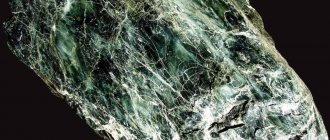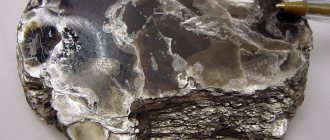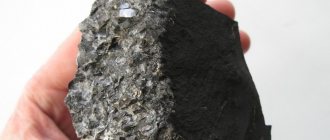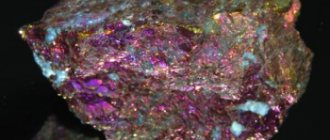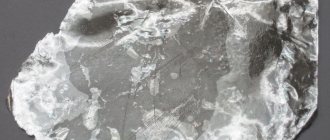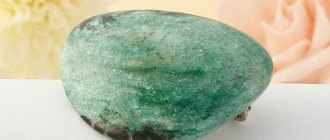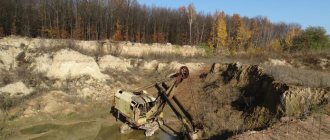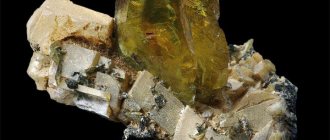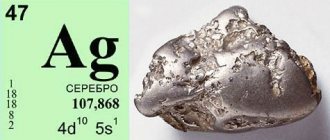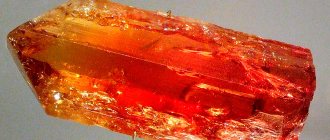| Category | Silicate minerals |
| Title in English | Biotite |
| Formula | K (Mg, Fe)3[Si3AlO10] [OH, F]2 |
| Group | Mica group |
| Color | Black, Brown |
| Stroke color | White, Gray |
| Shine | Glass |
| Transparency | Transparent, Translucent, Opaque |
| singonia | Monoclinic |
| Hardness | 2 — 3 |
| Cleavage | Very perfect by {001} |
| Density, g/cm³ | 2,8 — 3,4 |
| Kink | The mineral is elastic, flexible, splits into leaves |
| origin of name | The stone is named in memory of the famous French physicist Jean-Baptiste Biot. By the way, he was awarded the Rumford Medal - this award is awarded by the Royal Society of London for important research in the field of physics. |
| Morphology | Biotite is characterized by the presence of clusters of flakes, prismatic crystals, tablets, as well as elongated and isometric plates. |
One of the natural minerals of the mica group is called biotite, and is also known as odenite and iron mica. Thin plates of this stone are transparent, they can even be translucent, and large crystals have a pronounced glass luster, but lack transparency. The main constituent elements of biotite are compounds of potassium, iron and magnesium, the percentage of which depends on the specific deposit of the sample. The mineral is characterized by the presence of many impurities, among which compounds of fluorine, sodium, lithium, barium, manganese, cesium, titanium and strontium are found.
Biotite deposits
Natural biotite consists of lamellar, scaly and columnar crystals that occur in rocks of igneous and metamorphic origin, as well as in basalt and quite often in pegmatite veins.
Biotite deposits are often adjacent to minerals such as feldspars, garnets, muscovites and andalusites. — Advertising —
Large amounts of biotite are being mined in countries such as Italy, Russia, Scandinavia, Brazil, Greenland and Alaska. Large crystals, made in the form of flat sheets, were discovered in southern Norway. Their sizes sometimes reach several square meters. High-quality jewelry specimens are found in German, Canadian and Tanzanian deposits.
History of biotite
Biotite is an important rock-forming mineral of granite and granodiorite.
It is less typical for basaltic rocks, but it is very often found in pegmatite. Biotite with a fine-scale structure is common in rocks of metamorphic origin, for example, in contact hornfels, mica schists, paragneisses, and orthogneisses. In general, the abundance of biotite is very high. Its crystallization temperature reaches 600-700 °C.
The name of this mineral is given in honor of the French chemist J.B. Biot, who studied the optical properties of mica.
Physicochemical characteristics of biotite
— Advertising —
The chemical composition of biotite is very variable. It contains oxides of potassium, magnesium, iron, aluminum, silicon in very different percentages, as well as many impurities, which include almost the entire periodic table.
Biotite crystals are characterized by a monoclinic system, perfect cleavage, and uneven fracture. They can be either transparent, translucent, or completely opaque.
The color range of the mineral includes shades of brown, dark brown, dark green, greenish-black, up to black. Biotite has a metallic, pearlescent or glassy luster.
Hardness on the Mohs scale is 2.5-3. Density ranges from 2.7 to 3.3 g/cm3.
Biotite is characterized by high elasticity, flexibility and fragility. It dissolves completely in concentrated sulfate acid. The phenomenon of pleochroism is characteristic. Crystals do not fluoresce. Weak radioactivity of some samples was also noted.
Biotite subgroup
The subgroup includes magnesium-iron micas: phlogopite and biotite.
Phlogopite
— KMg3[Si3AlO10] [F,OH]2, or K2O•6MgO•Al2O3•6SiO2•2H2O (translated from F to OH). The name comes from the Greek word “phlogopos” - fire-like (referring to the color of the mineral). Synonym: magnesium mica.
Chemical composition
(in%): K2O 7.0-10.3, MgO 21.4-29.4, Al2O3 10.8-17 (according to the formula it should be 12.2), SiO2 38.7-45.0 (according to the formula should be 43.2), H2O 0.3-5.4, F up to 6. Of the impurities most often present: FeO (up to 9%), BaO up to 2.5% (bariophlogopite), Na2O (up to 2%), as well as Fe2O3, sometimes MnO, CaO, Cr2O3, NiO, etc.
singonia
monoclinic;
monoclinic-prismatic c. With. L2PC. The crystal structure
of micas, as already indicated, is characterized by the fact that aluminum-oxygen tetrahedra (in the ratio Al : Si = 1 : 3) participate in the layers of silicon-oxygen tetrahedra. As a result, a residual negative charge arises between three-layer packets having the formula Mg3[Si3AlO10][F,OH]2, which is compensated by the monovalent cation K1+ (see Fig. 334-A). Unlike other micas, in phlogopite, Mg ions are located inside layered packets between two aluminum-silicon-oxygen layers in all places of six-fold coordination.
Fig. 328. Large phlogopite crystal. Slyudyanskoye field (Transbaikalia)
Crystal Appearance
tabular (pseudogexagonal), short-prismatic, sometimes truncated pyramidal.
The crystals are often roughly formed (Fig. 328) with pronounced parallel shading on the lateral faces. In shape they are indistinguishable from biotite crystals. Doubles are common. In general, mica twins can be formed according to various laws. Most often there are those in which the twin axis lies in the fusion plane (001) and, moreover, perpendicular to the c axis and the (001) edge: (110) (Fig. 329); the twin plane is therefore perpendicular to the (001) plane. This is the so-called mica law
of twinning.
According to the same law, tees with a common pinacoid {001} are also formed. In such tees, individuals sprout each other (Fig. 330). They often exhibit a feathery structure relative to twin sutures, due to the fact that rectilinear thin folds or roughly defined strokes are located perpendicular to the (110) : (001) edge. Another law, not typical for micas, is called chlorite; the twin plane coinciding with the fusion plane is (001). Aggregates are
leafy-lamellar, scaly.
Rice. 329. Double according to the mica law
Color
phlogopite is light yellowish-brown or reddish-brown;
less often colorless, silvery, sometimes with a greenish tint; dark brown in thick plates. The luster
is glassy, pearlescent on the cleavage planes. Ng = Nm = 1.565-1.606 and Np = 1.535-1.562.
Fig. 330. Germination tee according to the mica law
Hardness
2-3.
Thin sheets have elasticity. The cleavage
is very perfect along {001];
imperfect cleavage appears along {110} and {010}, which are slip planes. These planes are clearly visible in the so-called impact figure
, which is obtained for all micas on the cleavage plane (001) if a blunt needle is placed on it and sharply hit with a hammer.
As a result, systems of three intersecting lines diverging from the point of impact are formed, like a six-rayed star (Fig. 331). Two rays are almost exactly parallel to the edges of the {110} prism, and the third, longest line is parallel to the plane of symmetry. If, however, a thick plate placed on something soft is pressed not with a needle, but with a ball or the rounded end of a cylindrical stick, then a pressure figure
, that is, a six-rayed star with the directions of the rays perpendicular to the ribs (Fig. 331).
These directions are rotated by 30° compared to the impact figure. Both figures are characteristic of all mica-like minerals. Ud.
weight 2.70-2.85.
Other properties
. It has very high ohmic resistivity and electrical insulator properties.
Fig. 331 Impact figure (a) and pressure figure (b) on the mica cleavage plane
Diagnostic signs
. Light varieties of phlogopite are practically indistinguishable from muscovite in appearance, but the optical constants are different: phlogopite, like other magnesium-iron dark micas, is optically almost uniaxial, while muscovite is clearly biaxial and has a large angle of optical axes. It differs from biotite in its lighter color.
P. p. tr. melts with great difficulty (melting point 1330°). Decomposes in acids, especially in H2SO4.
Origin
.
Quite often found in contact-metasomatic
formations and in
pegmatite
veins cutting dolomitized limestones or other magnesian rocks poor in silica and iron (for example, serpentinites). Typical companions of phlogopite are diopside, forsterite, spinel, dolomite, calcite, feldspars, scapolites, etc. It is also common in metamorphic rocks (crystalline schists), usually in association with relatively iron-poor minerals. Without measuring optical constants, it can easily be mistaken for muscovite.
Practical significance
have coarse-crystalline masses of phlogopite. For application, see muscovite.
Place of Birth
.
The Slyudyansk
phlogopite deposits are located near the lake. Baikal, near the station. Slyudyanka, Zabaikalskaya railway e. In a genetic connection with granite intrusions, numerous cutting pegmatite veins and metasomatic formations were formed here among a complex complex of crystalline schists, gneisses and marbles. Phlogopite-bearing mineral bodies are usually subordinate to pyroxene-amphibole gneisses and are often found in groups. The structure of such veins is quite complex. Diopside-phlogopite formations develop in the side rocks (regardless of their composition). Large-crystalline phlogopite is usually associated with diopside, scapolites, calcite, apatite and other minerals. The crystals are often barrel-shaped, often with a sharp end, sometimes measuring up to 1.5 m in length. According to their color, the following types of phlogopite crystals are distinguished:
- colorless or with a yellowish tint;
- silvery-white, mainly among limestones;
- amber - among aplite-like gneisses;
- cherry or amber red;
- dark brown, sometimes with a golden tint;
- dark green and
- almost black - among pyroxene-hornblende and biotite gneisses.
When weathered, ferruginous phlogopites lighten and turn blue. Inclusions of calcite, scapolite and diopside are often observed among phlogopite crystals, and under a microscope, rutile is also identified in the form of the finest needles (saguenite), etc. Similar phlogopite deposits are common in the Aldan region of Eastern Siberia.
Ontario are in approximately the same conditions.
(Canada) in the form of veins and irregularly shaped nests.
Phlogopite occurs in association with calcite, diopsidochm and apatite in a wide variety of quantitative ratios. The crystals reach 2 m in diameter. Amber coloration is most common. The same type of deposits are known in Madagascar, Ceylon, India, Korea
and other places.
Biotite
— K(Mg,Fe)3[Si3AlO10][OH,F]2, or K2O•6(Mg,Fe)O•Al2O3 •6SiO2•2H2O. A very widespread mineral.
Chemical composition
. Analyzes of minerals called biotites showed the following variations in their composition (in%): K2O 6.18-11.43, MgO 0.28-28.34, FeO 2.74-27.60, Fe2O3 0.13-20, 65, Al2O, 9.43-31.69, SiO2 32.83-44.94, H2O 0.89-4.64, F 0-4.23. Impurities: TiO2, Na2O, as well as Li2O, MnO, BaO, SrO, Cs2O, etc.
Rice. 332. Biotite crystals. Ilmen Mountains (Ural)
singonia
Monoclinic.
Monoclinoprismatic c. With. The shape of the crystals
is tabular, pseudohexagonal,
often
columnar, pyramidal (Fig. 332).
Large crystals sometimes have a zoned structure. Doubles are usually according to the mica law. Aggregates
. It is found in continuous lamellar and scaly-granular masses. Drusen crystals are relatively rare.
Color
biotite is black, brown, sometimes with orange, reddish, greenish and other shades.
Opaque or translucent. The luster
is glassy, on the cleavage planes with a pearlescent tint. Ng = Nm = 1.60-1.66 and Np = 1.56-1.60.
Hardness
2-3.
Individual thin leaves have elasticity. The cleavage
is very perfect along {001} and imperfect along [110] and {010}.
Ud.
weight 3.02-3.12.
Diagnostic signs
. Macroscopically recognizable by its black color and characteristic external features. Under a microscope, it is easily identified by its thick color and pronounced pleochroism.
P. p. tr. melts with difficulty into gray or black glass. HCl has a weak effect, but in concentrated H2SO4 it decomposes completely with the precipitation of a white silica skeleton.
Origin
. As a rock-forming mineral, biotite is found in the form of inclusions in many igneous rocks.
In large crystals, biotite is observed in pegmatite
veins
It is also found in association with muscovite, with which it sometimes forms parallel or zonal intergrowths, the cleavage planes passing through individuals of both micas without interruption. In the form of dissemination, it is often established in the so-called contact hornfels
, formed under the influence of granite magmas, usually on rocks of non-carbonate composition.
In hydrothermal ore veins, biotite is extremely rare, and usually in a dilapidated state.
Very widespread in some metamorphic
rocks: crystalline schists, in particular gneisses.
During the process of intense chemical weathering, it undergoes decomposition. In this case, alkalis are removed, divalent iron becomes trivalent. At the same time, hydration apparently occurs (transition to hydrobiotite). The mineral loses its shine, elasticity, and becomes friable. In the final stage of chemical decomposition, iron hydroxides and clay matter are formed.
With rapid erosion, biotite, as a chemically relatively stable mineral, turns into placers, is easily split, crushed and deposited together with the finest silty material in stagnant waters. Here it undergoes some changes over time and acquires an intense golden hue. These golden sparkles are easily detected during washing: as a lighter material, they are deposited on the surface of the washed sediment. In common parlance they were called “cat’s gold.”
It has also been established that in modern marine sediments biotite grains undergo the process of halmyrolysis, i.e. underwater “weathering”, and they gradually turn into glauconite - a green hydrosilicate of potassium and ferric iron.
Has no practical significance. Ural handicraftsmen use it only as a shiny material when making children's toys and various items for decoration from colored stones.
Place of Birth
.
Among the mineral types of mica, biotite is the second most abundant in nature after muscovite. Of the countless deposits, we will note only a few, partly already familiar to us, pegmatite deposits. In the Ilmen Mountains
, biotite as a minor mineral is unevenly but widely distributed in all types of pegmatite veins in the form of large plates (up to 0.5 m in diameter), crystals and small-plate aggregates in association with potassium feldspars, nepheline, sometimes topaz, magnetite, ilmenite and other minerals.
In the Borschovochny
Ridge, biotite is noted in pegmatites near the village of Savvateeva, in the area of the river.
Slyudyanka
and other places.
Huge plate-like crystals were observed in pegmatites of Greenland and Scandinavia
(a biotite plate measuring 7 m2 was found in Evje).
Types of biotite
Depending on the color of the mineral, which in turn is determined by the content of certain impurities, several subspecies of biotites are distinguished:
- Lepidomelans are specimens of a rich, absolutely black color;
- Meroxenes are biotites, which contain a reduced amount of iron compounds, light stones;
- Rubellans are brownish or brick-red biotites;
- Siderophyllites are a subspecies in which there are no magnesium compounds, but a lot of iron compounds, colored in greenish tones.
Main varieties
Biotite in jewelry
Biotite has the following varieties:
- Bowerite (cat's gold) is a stone with a bronze color;
- Meroxene is a mineral with a small proportion of iron in its composition;
- Rubellan is a biotite with a rich red-brown color;
- Lepidomelan is a black stone saturated with iron oxide;
- Siderophyllite is a mineral of dark brown shades, reaching black, which includes a high percentage of iron with a minimal amount of magnesium;
- Glauconite (hydromica) are green crystals that have been transformed due to the influence of sea waters. Scientists classify this mineral as an independent group, considering it not a variety of biotite, but an independent unit.
The magical properties of biotite
Depending on the color of the stone, its magical abilities change.
So, in order to attract money and prosperity, a small piece of bronze biotite is placed in the wallet compartment. Delicate green crystals can give peace of mind and tranquility, while pink and red specimens improve family relationships and help spouses achieve complete mutual understanding. Sorcerers use biotites to contact their patrons, develop the gift of prophecy and intuition. It is believed that when used correctly, this stone reveals the secrets of the universe, relieves energy blockages and greatly enhances the psychic abilities of its owner.
Who is suitable according to their zodiac sign?
Compatibility table of biotite with zodiac signs (“+++” – fits perfectly, “+” – can be worn, “-” – is strictly contraindicated).
| Zodiac sign | Compatibility |
| Aries | + |
| Taurus | + |
| Twins | + |
| Cancer | + |
| a lion | + |
| Virgo | + |
| Scales | + |
| Scorpion | + |
| Sagittarius | + |
| Capricorn | + |
| Aquarius | + |
| Fish | + |
Healing properties of biotite
In lithotherapy, biotite has the same healing properties as mica. It is recommended for harmonizing the state of mind, getting rid of constant stress, neuroses, stiffness and shyness. With the help of this mineral, sleep is normalized, blood glucose levels are leveled, and hormonal balance is normalized. In general, the effect of the stone is characterized as restorative and stimulating to the immune system.
Care and storage
Biotite is very fragile, so you should be extremely careful when handling it.
Products containing mica must not be dropped, impacted or exposed to acids. An amulet with biotite can be recharged in the sun at an energy level, but it is not recommended to expose it to prolonged exposure to ultraviolet radiation. After recharging, the crystal should be removed to a dark place.
Biotite should be cleaned of contamination monthly. To do this, the stone is rinsed under running water and dried. The frame of the product with mica should be cleaned so that the cleaning agent does not get on the insert.
Industries of biotite application
Biotites are used very widely and in a wide variety of industries.
Due to its excellent insulating properties and resistance to high temperatures, the mineral has found application in radio engineering and electronics production, as a substitute for synthetic substances. Biotite is also part of a substance such as vermiculite, which is very popular today in the construction industry, and is used in thermal insulation of buildings, as well as in agriculture as a microelement fertilizer, which significantly increases crop yields. In addition, biotite is used to cladding wood products, and in appearance and quality they resemble inlaying with mother-of-pearl. Biotite powder is added to paints to add shine and shine. When enamel compositions for the production of wallpaper and plastic products are enriched with biotite, a very beautiful effect is obtained.
Even the cosmetics industry has found use for finely ground biotite powder. Instead of mother-of-pearl, it is added to powder, eye shadow and blush.
Mineralogy uses biotites to determine the conditions and age of formation of a particular rock.
Crystals of this stone of unusual shape or color are in demand among collectors. In jewelry, both untreated and cabochon-cut specimens are used. They are used to make bracelets, rings, earrings, pendants and other jewelry.
How to distinguish from a fake?
Unscrupulous sellers often pass off painted plastic or ceramics as natural odenite. You need to know how to distinguish the original from the fake:
| Signs | Real stone | Fake |
| Shine | Metal. | Matte. |
| Price | Can't be low. | |
| Thermal conductivity | Remains cold for a long time. | Heats up quickly in the palms. |
| Sound when tapping on glass surface | Deaf. | More sonorous. |
| Weight | Heavier. | Easy. |
If you look at the samples through a powerful magnifying glass, you can see that the stone, born in nature, has stains and irregularities. And the surface of the imitation is always smooth and even.
BIOTITE FAKE
Interesting facts about biotite:
- Due to its layered structure, biotite is a kind of chronicle in geology. Its composition is very variable depending on the external conditions in which the mineral is formed, and therefore its chemical analysis shows the entire process of stone formation. With the help of such analysis, geologists draw conclusions about processes that occurred in rocks a long time ago.
- Biotite is such a soft stone that it can melt under the influence of a candle. If the sun's rays fall on it for a long time, it fades and turns into green chlorites or muscovites.
Compatibility with other stones in jewelry
When purchasing jewelry that combines several gems, you must remember that not all crystals are compatible. Biotite is compatible with only a few stones.
Odenite and granite complement each other. A pendant with them will help a woman get rid of headaches and give her the strength not to be irritated with others.
Natural white pearls and black mica look impressive together. This decoration will suit any outfit. Do not forget that the talisman will protect against the negative energy of envious people.
Important information
Under no circumstances should you buy accessories that contain biotite together with lapis lazuli, moonstone, aquamarine, or heliotrope.
And the combination of biotite with malachite, variegated agate, and carnelian is considered neutral.

